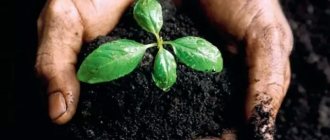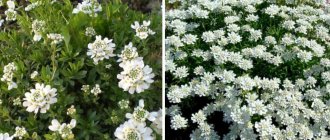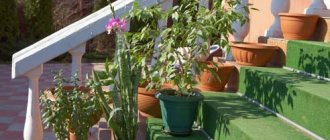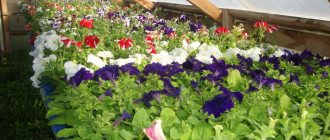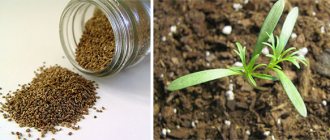Many people who have a dacha or their own country house often have the question, “What flowers can be grown if the soil is acidic?”
In order to determine this, you need to understand the acidity of the soil, which is measured in pH. The most optimal or neutral soil is a soil with a pH of 7. If the pH is greater than 7, then it is an alkaline environment, and if it is less, it is acidic.
The most optimal soil pH for most plants is 5.5-7.5.
ACIDIC SOILS: SOUND THE ALARM OR SEEK A SOLUTION
Acidic soils are a significant obstacle to the development and fruiting of a large number of garden and garden plants. Excessive acidity, interacting with nutrients, prevents the latter from being absorbed by plant roots, which leads to starvation and decreased immunity in garden crops.
With frequent watering and precipitation, excess acid is washed out of the soil, which allows a number of plants to develop normally, however, when some fertilizers are applied, the acidity of the soil increases again, and the crops stop growing again. Maintaining pH balance is very important for the health and development of garden plants.
Checking the acidity of the soil on the site before planting crops is a very correct and intelligent decision, because it is based on the results of soil testing that you can choose suitable crops for the garden.
There are a lot of ways to check, but the most accurate results will be when using litmus paper or a special device to determine the pH level.
PH METERS: HOW TO USE
The device allows you to quickly determine the acidity of the soil on the site. [Acidity level scale]
The operating algorithm is as follows:
- Clear the area of debris.
- Moisten the soil with water, wait until the moisture is absorbed into the soil.
- Wipe the device rod dry with a cloth and immerse it in the soil (at least 15 cm).
- The soil next to the probe should be compacted.
- Measurements are taken in several places on the site, after which the results are summarized and the total value is displayed.
Some weeds can also give a hint about acidification of the soil in the area: horsetail, moss, sorrel, wood lice, mint, pigweed, and buttercup. Plants that love acidic soil simply thrive in areas with high acidity.
There are two ways to grow rich crops in acidified areas:
- Preliminary soil deoxidation is an active method that requires physical effort and material costs.
- Using a special group of plants that like to grow in acidic soil is a more passive way to get around the problem.
It is the gardener’s decision to choose one or another option, but both of these methods have approximately the same efficiency.
Soil deoxidation can be carried out using several methods:
- Sowing green manure, which not only enriches the soil with nitrogen, but also loosens it to a considerable depth with roots: legumes, rye, oats, vetch, phacelia.
- Adding ash to the site is 0.2 kg. per 1 m2.
- Liming - adding slaked lime to the upper layers of the soil; you need to add from 0.2 to 0.5 kg of the substance per 1 m2. The method is suitable for areas with heavy clay soil. Adding chalk and dolomite flour - used in areas with sandy light soil, the rate of application of substances is from 0.2 to 0.3 kg per 1 m2.
The second method is the selection of special plants, the easiest, because you can always select the necessary species and varieties, which will help you get a rich harvest of fruits, vegetables and berries and enjoy the beauty of flowering and ornamental crops that need acidic soil for normal development.
What plants are grown in soils of different acidity?
A roughly established classification of the main agricultural and indoor crops depending on the requirements for the reaction of the soil solution will make your search easier:
- On neutral or slightly alkaline (pH 7.0–8.0) soils, asparagus, onions, celery, cabbage plants (cauliflower), mustard, parsley, as well as raspberries, peonies, and delphinium thrive.
- On neutral and slightly acidic soils (pH 6.0–7.4), almost all vegetables will bear fruit with gratitude: carrots, radishes, cucumbers with other pumpkins, legumes (peas, beans), spinach, beets, lettuce, garlic and the main part nightshades (tomatoes, eggplants, bell peppers). In addition, currants, red currants, sea buckthorn, gooseberries and most stone fruits love such areas. They are favorable for the bulk of garden flowers.
- Pome fruits, black currants, honeysuckle, strawberries, potatoes, lilies, and phlox grow well on slightly acidic soils (pH 5.5–6.0).
- Corn, raspberries, blackberries, watermelons, melons, and radishes are placed on medium-acid ones.
It should be borne in mind that there are often plants that perfectly tolerate various environmental conditions, adapting and changing their properties. An example of this is the large-leaved hydrangea flower. By the color of the flowers, you can understand what level of acidity she has chosen: in an acidic environment, the color of the flowers is blue, in an alkaline environment - pink, in a neutral environment - white-beige. Therefore, it is easy to control the color of the flowers you like.
| Reference. Acidity tolerance may change as plants age. Young plants are most sensitive to this indicator. An acidic environment has the most powerful effect on plant organisms at the beginning of the growing season. Please note that for many garden crops, failure to comply with the necessary conditions for the level of soil acidity can be disastrous. |
However, acidic soil is not always a problem. The list of plants that love acidic soil is quite extensive. Consequently, from such plants it will be possible to easily create completely decorative areas, forming a unique landscape. Soils with pH values in the range of 5.5–6.5 are most preferable for these crops.
Zinnia
Plants are planted in open ground in the second half of May. The soil should be neutral, but slightly acidic will do. The main thing is that the area for the zinnia is bright, protected from the north wind.
It is advisable to take a nutritious soil substrate; if necessary, fertilize the flowerbed with organic matter. Good drainage is also necessary.
- Author: Inna Kiseleva
Rate this article:
- 5
- 4
- 3
- 2
- 1
(1 vote, average: 5 out of 5)
Share with your friends!
What plants like acidic soil: list
Let's look at a situation where you have a plot with acidic soil, and there is no possibility, and sometimes no desire, to correct this situation in the near future. Don't be upset. There is always a way out! It turns out that there are a significant number of plants that love it. Here are some of them.
What plants like acidic soil in the garden?
Such acidophilic plants, also called acidophytes, include almost all conifers, forest berries (blueberries, lingonberries, as well as medicinal blueberries and cranberries), azaleas, wild rosemary and many other representatives of the plant world.
Ferns
Plants that inhabit acidic areas everywhere. Their most common representative is the decorative multi-row spiny plant, which has an attractive spreading bush.
Shrubs
Rhododendrons are widespread across our vast territory - tall, up to two meters, shrubs that are pleasing to the eye from April to July, as well as their late varieties such as rhododendron Veresk, low, no more than half a meter in height, growing until the month of October. Most of their representatives are winter-hardy, but there are specimens that require special shelters in harsh climates.
Flowers
Everyone's favorite peonies prefer acidic soils, with very low pH values. In such beds, the flower grows well up to 1.5 m, bushes and pleases us with lush color. Perhaps for this reason it is not possible to grow your favorite flower in your area.
Lupine simply loves such soils. Moreover, the more sour, the better. In such conditions, it can grow up to a meter or even higher, and is also an excellent green manure.
Forget-me-nots and lilies of the valley also grow well in such places. Lilies can also be placed in acidic areas. True, not all, but only Asian hybrids.
It may come as a surprise to some that the queen of flowers, the rose, simply loves sour areas. Try to please the rose bushes, add special acidifiers to the soil. However, there are some varieties with other soil preferences. Therefore, be careful. Read the characteristics of the variety before purchasing in a store or nursery.
Poppies, purslanes, various carnations, which grow quickly in June-August, being an excellent honey plant, attract pollinating insects. It does not react at all to the high acidity of zinium, regardless of the wide variety of its types.
Trees
You can plant coniferous trees of any kind, creating a wonderful corner for relaxation. Both stylish and reasonable.
Vegetables
Surprisingly, the most popular garden crop, potatoes, also prefers a pH level of less than 6.0. If, during harvesting of this crop, a large number of root crops infected with scab disease are noted, it is time to conduct an acidity test.
Which houseplants like acidic soil?
Indoor plants: azaleas, camellias, fuchsia, cyclamen, monstera, begonia, pelargonium, asparagus also prefer non-alkaline soils. To plant them, you should prepare a substrate with a predominance of peat (preferably high peat) and compost obtained from rotted coniferous or oak leaves. For even greater acidity, sphagnum moss can be successfully used.
However, most of us prefer to buy soil from the store. The packaging must contain a mark indicating the acidity value. You can also acidify the soil using sawdust, pine litter, and fresh manure. Other home methods for this are also applicable: using lemon or sorrel, as well as ordinary citric acid - dissolve 15 g in a liter of water.
LiveInternetLiveInternet
—Categories
- Hand Made (362)
- Master class (144)
- Embroidery (105)
- Sewing (50)
- Toys (45)
- Creative ideas. (26)
- Decoupage (22)
- Decor (158)
- Knitting (157)
- Crochet (136)
- Knitting (24)
- Vintage (68)
- Pictures (52)
- Interior (51)
- Touches for a portrait (38)
- Attic of Thoughts (27)
- Interesting things (5)
- Beauty is a terrible power (37)
- DIY natural recipes. (16)
- Cooking (28)
- Baking (15)
- Snacks (8)
- My works (26)
- Decor (15)
- Knitting (14)
- Toys (11)
- Hand Made (7)
- Newspaper weaving (7)
- Vintage (4)
- DIY icon restoration (1)
- Design (1)
- Useful things, cheat sheets. (24)
- Let's be healthy (22)
- Art (21)
- Photos (12)
- Video (6)
- Music (2)
- Painting (2)
- Design (21)
- Flowers (17)
- Newspaper weaving (16)
- Diary design (14)
- Dedicated to dogs (5)
- Once upon a time there was a pug (2)
- Perfume is an autograph of a person. (4)
- Audiobook (2)
—Search by diary
—Subscription by e-mail
— Regular readers
—Communities
-Statistics
How to increase soil acidity
Sometimes, but extremely rarely, there is a need to increase the pH. Although it usually happens the other way around. But for example, you really want to have an avid acidophyte on your site. What to do? Bring in acidic peat and use it as an organic fertilizer, mixing it with the existing soil in an area pre-designated for your intended pet. There are other ways to make an area more acidic:
- add acidic complex fertilizers, the choice of which is huge in stores, and any seller will help you;
- add compost or manure, which will help to slowly acidify the soil;
- simultaneously with digging, add waste from coniferous trees: shavings, sawdust, litter;
- use urea - one of the fastest acidifiers.
| Advice. Before drawing up a planting plan on your site, be sure to take into account the acidity of the soil solution. Do not rush into carrying out special work on liming the entire area. Take this fact into account when placing crops that prefer acidic soils |
Asian lily hybrids
Asiatic lilies tolerate slightly acidic soils. Complex hybrids have direct roots of East Asian origin. This is a very large group where hybrids and garden forms originate from the following types of lilies: tiger, lanceolate, calloused, drooping, dwarf, single-colored, David, Ward, single-colored and interspecific hybrids of Dutch and spotted lilies.
It is advisable to choose sunny areas for these plants, but they can also develop well in shade.
Flowers that love acidic soil
Most people who have acidic soil wonder what flowers love it . First you need to measure the acidity of the soil. If it has a pH value of 5.5-6, then on such land you can safely grow:
- lilies of the valley;
- zinnia;
- aster;
- primrose;
- cornflower;
- sage;
- sunflower;
- nasturtium;
- space;
- calendula;
- crocus;
- chrysanthemum;
- anthurium.
However, in this matter we should not forget that if the pH of the soil is alkaline or neutral, then the plants on this land will not be able to grow normally and produce the necessary flowering. This is especially true for flowers, since they are planted mainly to decorate a plot of land and make it more attractive.
Creeping tenacious
Creeping creeper (Ajuga reptans) is a fast-growing ground cover. Begins to bloom in late spring. Pyramid-shaped inflorescences of purple, pink, white flowers. Prefers slightly acidic soil. This plant of forests and steppes smoothly migrated to our areas. Many people like its early flowering, and others choose it as a good ground cover. And such a useful decoration will always find its place in a rock garden.
Be that as it may, demand creates supply, and now the survivor has many beautiful varieties. Personally, I really like the Pink Elf variety - the bushes are very compact, and the flowers range from light pink to dark pink.
Ornamental plants that love acidic soil
Today it has become very fashionable to grow not just ordinary flowers or any other plants on your plot of land, but also to plant ornamental ones. Quite unusual and ornamental plants include:
- rhododendron or azalea;
- heather;
- caustic buttercup (is poisonous);
- moss;
- marsh viola;
- hydrangea;
- viburnum;
- May lily of the valley;
- Fortegilla Gardena;
- multileaf lupine.
Not only do they love acidic soil, but they also have a very unusual appearance. So such flowers can decorate absolutely any plot of land and make it completely unusual.
Azalea or rhododendron
Azalea (Azalea) is part of the rhododendron genus; this is usually the name given to beautifully flowering rhododendrons of various species (Indian azalea - Rhododendron simsii, Japanese azalea - Rhododendron obtusum). This is a deciduous or evergreen shrub belonging to the heather family (rarely small trees), it is very decorative, but quite thermophilic. It begins to bloom in early summer and simply requires acidity in the soil for good development. Medium acidity works best. It is necessary to provide this plant with coolness, light shade, drained but well-moistened soil, and lush flowering will not take long.
In the middle zone there may be difficulties associated with wintering. Therefore, pay attention to zoned varieties and choose places for rhododendron wisely - protected from winds and direct sunlight. Preferably on slopes where the sun is only in the first half of the day, or near not very tall spruce and pine trees. Heavy, clayey, ever-wet soils should be avoided.
Various crops that prefer acidic soil
In addition to flowers and ornamental plants, vegetables also prefer acidic soil, such as:
- potato;
- sorrel;
- pumpkin;
- tomatoes;
- carrot;
- rosemary;
- cucumber;
- turnip;
- spinach.
The following trees germinate and bear fruit well in acidic soil:
- maple;
- Apple tree;
- juniper;
- dogwood;
- witch hazel;
- magnolia;
- acacia;
- birch;
- blueberry.
On acidic soils, in addition to a variety of crops and flowers, weeds can also be parasitic. This type of soil is preferred:
- toric;
- bear ear;
- nettle;
- sow thistle;
- wild radish;
- fern;
- sorrel;
- plantain.
If the soil in the garden is too acidic or even alkaline, then this is not a death sentence for the gardener. Often, ash or lime is used to deoxidize the soil. They will be able to quickly bring the soil to the required pH and then you can safely grow the desired crops on it.
Provided that the soil is slightly acidic, then fertilizers such as ammonium sulfate can be used to acidify it. Or simply increase summer watering - this will also help increase soil acidity.
Lupine multileaf
When the construction of our “nest” was just beginning, there was a field all around, completely dotted with multi-colored lupins. There were pink, purple, and white flowers here. In addition to doing well in slightly acidic soil, lupins (Lupinus polyphyllus) also make excellent green manures that improve soil quality. This is facilitated by special bacteria that store nitrogen and live in nodules that form on the roots of the plant. With good development, lupine bushes are strong, reaching a height of 50 cm.
WHAT PLANTS NEED ACIDIC SOIL: REVIEW OF SPECIES
First, it’s worth talking about trees - after all, they form the basis of any garden. The first tree in the garden is an apple tree; it is the one that is tolerant of the increased acidity of the soil and bears fruit well in such conditions. Interesting varieties that can be planted on slightly acidic soils: Melba; Antonovka dessert; Cinnamon Striped; Granny Smith; Red Delicious; Golden Delicious.
Japanese quince is another representative of the Rosaceae family, which can easily develop in acidified soils. The best varieties: Crimson and Gold; Clementine; Garnet bracelet; Rubra. Japanese quince produces small, edible fruits; during the flowering period, it decorates the garden with numerous carmine-red or orange flowers.
Dogwood is a shrub or tree with numerous oblong berries with a refreshing sour taste. The culture grows well both in soils rich in lime and in slightly acidic soils. The plant bears fruit in early autumn and is resistant to winter frosts. Productive varieties: Coral; Big Apple; Amber; Red Star.
Birch - a white-trunked beauty - grows well on problematic soils. The best varieties for landscape decoration: Golden Treasure.
WHAT ORNAMENTAL PLANTS LOVE ACID SOIL
In fact, there are not many ornamental plants that thrive in areas with high acidity.
- The rose itself, the queen of flowers, develops well in slightly acidic soils. There are a lot of varieties of roses; you can choose varieties for creating borders and hedges, planting in groups and containers. Climbing roses are ideal for growing in tandem with clematis. Among them, noteworthy varieties are: Black Queen; Gloria Clyming; Golden Carpet.
- Rhododendrons are spectacular and graceful at the same time; these plants prefer to live in nature on soils with high acidity. Any imbalance and alkalization of the soil will lead to the death of charming plants. The best varieties of rhododendrons for garden decoration: Hanya; Tenderness; Blue Silver; Red Jack.
- Hydrangeas - the average soil pH for this flower is close to 5.5. Plants thrive in areas with such acidic soil, delighting with numerous caps of bright flowers. Recommended varieties: Red Miss Hepburn; Nikko Blue; Fiery beauty; Endless summer.
- Magnolia is a spectacular tree with flowers that look like graceful butterflies. You can always choose a variety to decorate your garden, the best of them are: Nigra; Susan; Black Tulip; George Henry Kern.
- Japanese maple is an elegant tree with incredibly beautiful leaves that change color in the fall. Among these plants, one can note the chic varieties: Orange Dream; Wilson Pink Dwarf; Flamingo; Little Princess.
Of the flower crops in areas with high acidity, lupins, peonies, nasturtiums, poppies, purslane, ferns, chrysanthemums, heather and simple village cornflowers grow well. Ground cover purslane can also grow on problematic soils.
Berry bushes produce excellent yields on acidic soils: raspberries, honeysuckle, cranberries, blueberries, blueberries, and viburnum.
Even in acidified areas you can grow a fragrant garden; all you have to do is choose the right plants.
Site articles on the topic
- When to sow seedlings in April 2022 according to the lunar calendar
- What indoor plants bloom without problems in winter?
- How to properly prepare cuttings for scion and save them until spring
- Mistakes when preparing flowers for winter
- 4 important rules for autumn soil fertilization
You may also find the following materials useful:
- Echinacea purpurea is not only a medicinal plant, but also a very beautiful flower.
- How to Preserve Flower Bulbs in Winter
- Options for summer flower beds that you can admire from the heart
- Rose care calendar by month
- What to do with tulips when they have bloomed
May lily of the valley
Lilies of the valley (Convallaria majalis) have long become a symbol of spring and tenderness. Having brought a lily of the valley to my house once, I never regretted it. They are perfectly adapted to soils of medium acidity, but prefer slightly acidic soil. The bright greenery, complemented by lovely little white bells, will fit very well into any garden. It should be remembered that the fruits of this plant are poisonous, and remove the purple balls in time. I combine lilies of the valley with moss, spruce, as well as tree hydrangea and hosta.
